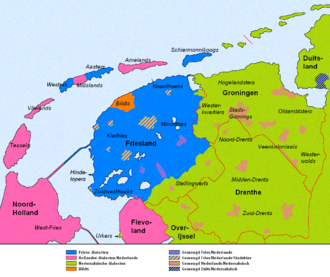| West Frisian | |
|---|---|
| Geographic distribution | Friesland and Groningen, Netherlands |
| Ethnicity | West Frisians |
| Linguistic classification | Indo-European
|
| Subdivisions |
|
| Language codes | |
| ISO 639-1 | fy |
| ISO 639-2 / 5 | fry |
| ISO 639-3 | fry |
| Glottolog | mode1264 |
 Present-day distribution of West Frisian languages (blue), in the Netherlands | |
| Notes | fry is ISO 639-2 and not ISO 639-5 |
The West Frisian languages are a group of closely related, though not mutually intelligible, Frisian languages of the Netherlands. Due to the marginalization of all but mainland West Frisian, they are often portrayed as dialects of a single language. (See that article for the history of the languages.)